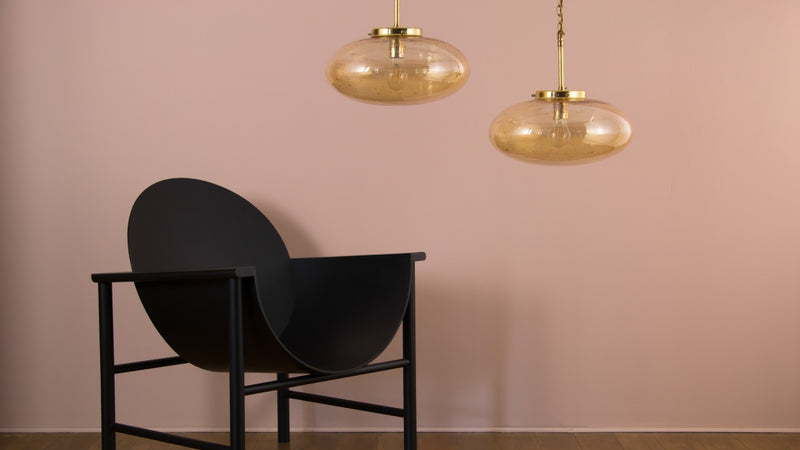
The resilient legacy of vintage Czech lighting
Czech glass makers are artists. From poets and painters to photographers and potters, artists have been using art as a medium to comment on society’s struggles and pick apart political upheaval since the beginning of time.
The political climate of the 20th century pushed artists to maintain their creativity through any medium possible, their innovation and passion allowed Czech glassware to survive despite the odds. The work we do at skinflint continues this ancient legacy. Meet the lights that cracked communism, one globe at a time in our latest collection, Czech Crystal: Bohemian Origins…

Above: Leading Czech glass artist Professor Josef Drahoňovský inspects his work. (Image credit: Rückl Crystal).
From pressed glass rosary beads, to chandeliers adorning Versailles Palace, the Bohemian region of former Czechoslovakia has been world renowned for producing high quality glass since the 13th century. The region's abundance of natural resources created a perfect hub for glass artisans to thrive, however, a new century delivered new challenges in the shape of not one, but two world wars.
The results of WW1 turned the industry on its head with Bohemia, Moravia and Slovakia merging into a new Czechoslovakian nation, heralding a new era for what we now know as ‘Czech glass’. Throughout this interwar period (1918-1939) Czechoslovakia made a firm mark on Europe, establishing itself as a modern nation where art, design and industry boomed.

Above (left): First Rückl showroom in Nižbor in the 1920s. Above (right): Glassblowers in Nižbor glassworks. (Photo credits: Rückl.com)
During WW2 and Nazi occupation, the glass industry took a huge blow and was left in shambles, the Sudeten Germans, who owned many glassworks in the Bohemian region were expelled from Czechoslovakia, leaving huge gaps in the industry. Not all was lost as young artists from Prague relocated to the countryside to fill these gaps and re-establish the legacy of Czech glass.
Two years later, one authoritarian rule was replaced with another as the Communist Party forcibly gained control. Under the notorious dictator Stalin, socialist realism became the only acceptable art form, with others seen as relics of decadent capitalism. Industry across Eastern Europe was nationalised and decorative glassware was declared unsuitable for the utilitarian ideals of communism. Factories once producing beautiful cut-glass pieces were forced into making laboratory equipment and glass chamber pots.
It’s hard to avoid images of severe Brutalist shapes and cold concrete buildings when thinking of 20th century Eastern Europe. Our Czech Crystal: Bohemian Origins collection of vintage lights turns this notion on its head, with beautiful, intricately cut glass globes, funky retro shades, and decadent chandeliers designed by artists desperate to express their creativity.

Image above: Sensitive restoration of the Retro Czechoslovakian pendants (v2) in the skinflint workshop.
With the death of Stalin, came the end of his reign of terror and a slight crease appeared in the Iron Curtain. The government began to see the value in glass once more. Decorative beads and chandeliers were put back on the production line and exported to the West and across the Eastern Bloc.
Despite a thaw in communist policy throughout the 1960s, art was still solely used for state propaganda. But the artistic potential of glass was overlooked, to the state, it was a utilitarian industry that held high economic value. Seizing this opportunity, many artists took refuge in glassmaking as a way to express themselves.
Examples of this artistic experimentation are unmistakable in many skinflint vintage lights from this era. The funky moulded glass texture of the Retro wall lights by Lustry Kamenicky Senov, typically associated with the West’s psychedelic sixties made its way into the design of these wall lights that would have lived in many private homes throughout the Eastern Bloc.

Above (left): 1970s Czech hotel chandelier by skinflint. Above (right): 1970s Lustry Kamenicky Senov chandelier by skinflint.
The 1970s is the most fascinating period of Czechoslovakian history we salvage vintage lights from. The Prague Spring of 1968 was a time of hope and freedom for Czechoslovakia. A more liberal leader gave hope to the people and a future without communism was on the horizon. Fearful of what this liberal government might do to the stability of Soviet influence in Europe, Soviet troops invaded Prague. Eventually, after much resistance, they took control and the policy of Normalisation began. Whilst it wasn’t a full return to the terror of Stalin’s rule, it wasn’t far from it.
Despite Normalisation, the lighting produced by Czech designers were as extravagant as ever. As restrictions tightened, an abundance of artists joined the array of designers desperate to express themselves. The 1970s Czech hotel chandelier came from the ashes of this failed uprising, showing that despite being knocked down yet again, creativity and expression always prevails.

Image above: The workshop team sensitively restoring the Retro Czech wall lights.
By the 1980s, the cracks in communist Europe were beyond repair. Shortly after the fall of the Berlin Wall in November 1989, Czechoslovakia was liberated and by 1992, it was peacefully split into the nations of Czech Republic and Slovakia. The glassworks of former Czechoslovakia were re-privatised and companies that were thriving over a hundred years ago are still in production today.
By salvaging and carefully restoring vintage lights to modern day electrical standards, their stories are able to continue for generations to come.
Explore the full Czech Crystal: Bohemian Origins collection here
Special thanks to Rückl.com for their archive imagery.
You might also like
A fresh take on neutrals this spring
Ushering in longer, lighter days with our latest Nuanced Neutrals collection of vintage lights, celebrating the understated finer details that only come with authentic heritage and age.
InteriorsIrish Examiner: Vintage View
Our vintage cut glass chandeliers have been included for their authentic 1970s nostalgia and vintage style.
In the pressBeyond Retro: Bringing retro styles to modern interiors
Modern Retro is in! Our experts cherry pick the best retro lighting trends, curating considered interiors that transcend design fads.
Interiors







